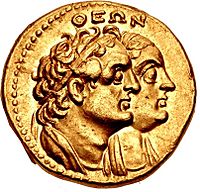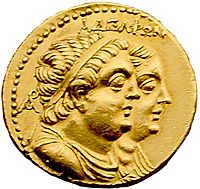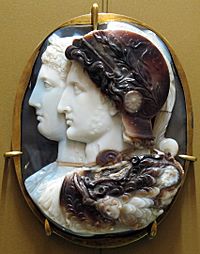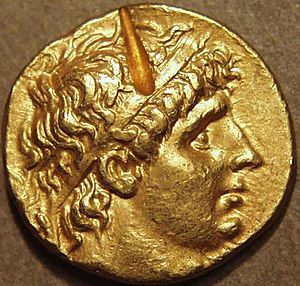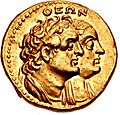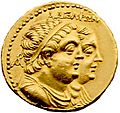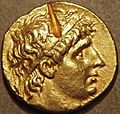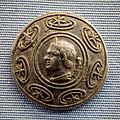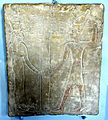Ptolemy II Philadelphus facts for kids
Quick facts for kids Ptolemy II Philadelphus |
|
|---|---|
| Koinē Greek: Πτολεμαῖος Φιλάδελφος; Ancient Egyptian: Userkanaenre Meryamun |
|

Bust of Ptolemy II, National Archaeological Museum, Naples
|
|
| Pharaoh of the Ptolemaic Kingdom | |
| Reign | 28 March 284 – 28 January 246 BC (Ptolemaic dynasty) |
| Predecessor | Ptolemy I |
| Successor | Ptolemy III |
| Consorts | Arsinoe I Arsinoe II |
| Children | With Arsinoe I: Ptolemy III Lysimachus Berenice, Queen of Syria With Bilistiche: Ptolemy Andromachou |
| Father | Ptolemy I |
| Mother | Berenice I |
| Born | c.309 BC Kos |
| Died | 28 January 246 BC (aged 62–63) |
Ptolemy II Philadelphus was a powerful pharaoh of Ptolemaic Egypt. He ruled from 284 to 246 BC. His full name, Ptolemaios Philadelphos, means "Ptolemy, sibling-lover." This name refers to his marriage to his own sister, Arsinoe II, which was a tradition for Egyptian pharaohs.
Ptolemy II was the son of Ptolemy I, a general of Alexander the Great. His father founded the Ptolemaic Kingdom after Alexander's death. During Ptolemy II's rule, the city of Alexandria became very famous. It was a center for learning and culture. He greatly supported the Museum and the famous Library of Alexandria.
His kingdom included Egypt, many Aegean islands, and parts of the Levant (the eastern Mediterranean coast). He tried to expand his empire, fighting wars with mixed results. He fought the Seleucid Empire in the First Syrian War and gained some land. However, he lost control of Cyrenaica when his half-brother rebelled. He also faced Antigonid Macedonia in the Chremonidean War for control of the Aegean Sea. Later, he lost some gains in the Second Syrian War.
Contents
Early Life and Becoming King
Ptolemy II was born on the island of Kos around 309 BC. His parents were Ptolemy I and his third wife, Berenice I. He had two full sisters, Arsinoe II and Philotera. As a young prince, Ptolemy was taught by famous thinkers of his time. These included Philitas of Cos and Strato of Lampsacus.
Ptolemy II had many half-siblings. His older half-brother, Ptolemy Keraunos, was expected to be king first. But as Ptolemy II grew up, they had a struggle for power. Ptolemy Keraunos left Egypt around 287 BC.
On March 28, 284 BC, Ptolemy I made Ptolemy II a co-ruler. This meant they ruled together. Ptolemy II was called 'King Ptolemy son of Ptolemy' in official papers. This helped tell him apart from his father. They ruled together until his father died in 282 BC. Most sources say Ptolemy I died of old age.
Key Events of His Reign
Family and Royal Marriages
After Ptolemy II became king, conflicts continued. He executed two of his brothers in 281 BC. His full sister, Arsinoe II, had been married to Lysimachus, another powerful ruler. Lysimachus's kingdom later collapsed.
Around 279 BC, Arsinoe II returned to Egypt. She soon had problems with Ptolemy II's wife, Arsinoe I. After 275 BC, Arsinoe I was accused of plotting against the king and was sent away.
Probably in 273/2 BC, Ptolemy II married his older sister, Arsinoe II. This kind of sibling marriage was a very old tradition for Egyptian pharaohs. It was seen as a way to keep the royal bloodline pure, just like the gods Zeus and Hera were siblings and married. This marriage set an example for future Ptolemaic rulers. They did not have children together.
The children of Arsinoe I, including the future Ptolemy III, were at first removed from the line of succession. But later, Ptolemy II made them the legal children of Arsinoe II. This made sure they could still become king.
Wars with Neighboring Empires
Ptolemy I and Seleucus I had disagreed over who controlled Syria. After both kings died, their sons, Ptolemy II and Antiochus I, continued the dispute. Ptolemy II used this time to expand his kingdom. He gained control of several areas like Samos, Miletus, and Caria.
Antiochus I then made an alliance with Ptolemy II's half-brother, Magas of Cyrene. Magas had declared himself king of Cyrene. Around 275 BC, Magas invaded Egypt. However, he had to turn back when local tribes attacked Cyrene. At the same time, Ptolemy II faced a problem with his own hired soldiers. He had 4,000 Gallic mercenaries who rebelled. Ptolemy left them on an island in the Nile where they died.
Expanding South into Nubia
Ptolemy II also fought with the kingdom of Nubia, south of Egypt. He wanted control of a rich area known as the Triakontaschoinos. This area was between the First and Second Cataracts of the Nile. Around 275 BC, Ptolemy's forces invaded Nubia. They took over the northern part of this land, which became known as the Dodekaschoinos.
This conquest was celebrated as a great victory. The new territory included valuable gold mines at Wadi Allaqi. Ptolemy started a large mining program there. The gold from this region helped make the Ptolemaic empire very rich and powerful.
The First Syrian War
In 274 BC, Ptolemy declared war on Antiochus I. This was likely a response to the alliance between Antiochus and Magas. Ptolemy's forces invaded Seleucid Syria. After some early success, they were defeated and had to retreat to Egypt.
An invasion of Egypt seemed likely. Ptolemy and Arsinoe spent the winter preparing defenses. But the Seleucid invasion never happened. Antiochus's army had problems with money and disease. In 271 BC, Antiochus agreed to peace. Things went back to how they were before the war. This was seen as a big victory in Egypt.
Developing Red Sea Trade Routes
Ptolemy II worked to improve access to the Red Sea. A canal from the Nile to the Gulf of Suez had been built long ago but was now blocked. Ptolemy had it cleared and reopened in 270/269 BC. He also founded the city of Arsinoe at the canal's mouth.
From there, two expeditions explored the Red Sea coasts. They set up 270 harbor bases. Some of these grew into important trading centers. Ports like Philotera, Myos Hormos, and Berenice Troglodytica became key for trade with the Indian Ocean. Further south, Ptolemais Theron was used to capture elephants for war.
On the eastern side of the Red Sea, settlements like Berenice (modern Aqaba) helped the Ptolemies access the incense trade routes. This led to strong ties with the Nabataeans.
The Chremonidean War

Egypt had been the strongest naval power in the eastern Mediterranean. Ptolemaic power reached into the Aegean Sea. But Antigonus II became king of Macedon in 272 BC and began to expand his power.
Ptolemy II and Arsinoe II presented themselves as protectors of Greek freedom against Macedon. Ptolemy made alliances with powerful Greek cities like Athens and Sparta. In late 268 BC, Athens declared war on Antigonus II.
A Ptolemaic admiral, Patroclus, sailed into the Aegean in 267 BC. He tried to help Athens, but the Spartan army could not reach them. The plan failed. After a long siege, Athens surrendered to Antigonus in 261 BC. The Athenian leaders who started the war fled to Alexandria, where Ptolemy welcomed them.
Ptolemy II did not fully commit his forces to the war in mainland Greece. His involvement was mostly financial support and naval help. The Battle of Kos was a major naval defeat for Ptolemy's fleet against Antigonus II. This battle marked the end of Egypt's complete control of the Aegean Sea. However, Ptolemaic naval bases in the Aegean continued to be important for many years.
The Second Syrian War
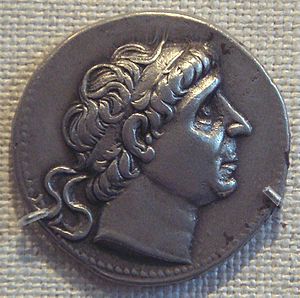
Around 260 BC, another war broke out between Ptolemy II and the Seleucid Empire, now led by Antiochus II. The war was about who controlled cities in western Asia Minor. This war also involved a rebellion by Ptolemy II's co-ruler, who took control of some Ptolemaic territories.
During this war, the Ptolemaic navy was defeated at Ephesus. Antiochus II then took control of key cities like Ephesus and Miletus. Ptolemy II himself invaded Syria in 257 BC. By the end of the war, Ptolemy had lost some land in Asia Minor.
In 253 BC, Ptolemy made a peace treaty. He gave up large areas in Asia Minor to Antiochus. The peace was sealed by the marriage of Ptolemy's daughter, Berenice, to Antiochus in 252 BC. Ptolemy paid a large sum of money as her dowry.
After the war, Ptolemy rewarded his soldiers. He gave them large plots of land in the Fayyum region. This area was named the Arsinoite nome, in honor of his sister-wife, Arsinoe II.
Later Years and Death
After the Second Syrian War, Ptolemy focused on Greece. Around 250 BC, his forces defeated Antigonus in a naval battle. He also started a festival called the Ptolemaia in Delos in 249 BC. This showed Egypt's continued interest in the Aegean islands.
Ptolemy also supported the Achaean League, a group of Greek city-states. With Ptolemy's money, this league grew stronger and became a threat to Macedonian power.
In the late 250s BC, Ptolemy tried to make peace with his brother Magas. They agreed that Ptolemy II's heir, Ptolemy III, would marry Magas's daughter, Berenice. When Magas died in 250 BC, Berenice's mother tried to break the agreement. But Berenice eventually married Ptolemy III in 246 BC, after he became king.
Ptolemy II died on January 28, 246 BC. His son, Ptolemy III, became king peacefully.
Ptolemy II's Rule and Legacy
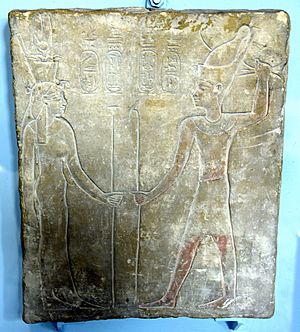
The Royal Cult
Ptolemy II changed the way the royal family was worshipped. He made the worship of Alexander the Great into a state religion for the Ptolemaic dynasty. He declared his father, Ptolemy I, and his mother, Berenice I, to be gods after their deaths. They were worshipped as the Theoi Soteres (Saviour Gods).
Around 272 BC, Ptolemy II and his sister-wife Arsinoe II were also declared gods. They were known as the Theoi Adelphoi (Sibling Gods). The main priest of Alexander was also named the 'Priest of Alexander and the Theoi Adelphoi'. This title grew with each new royal couple. In art, Ptolemy II was often shown with symbols of gods, like the club of Heracles. Arsinoe was shown with a cornucopia, a symbol of plenty.
Ptolemy also created cults for other family members. After her death, Arsinoe II was worshipped in her own right. Every temple in Egypt had to have a statue of her. This cult became very popular.
A big festival called the Ptolemaia was held every four years in Alexandria. It honored Ptolemy I. This festival was a chance for Ptolemy II to show off the wealth and power of his empire. A historian described one of these festivals. It included a huge feast and athletic games.
The highlight was a Grand Procession. It had many smaller parades for different gods. The procession for Dionysus alone had dozens of huge floats. Some floats had giant statues and moving scenes. There were also hundreds of people dressed as mythical creatures. Twenty-four chariots pulled by elephants were followed by a parade of wild animals. These included lions, leopards, camels, and even a rhinoceros. At the end, a huge army marched, with 57,600 foot soldiers and 23,200 cavalry. Over 2,000 talents of money were given out to people attending.
Egyptian Culture and Temples
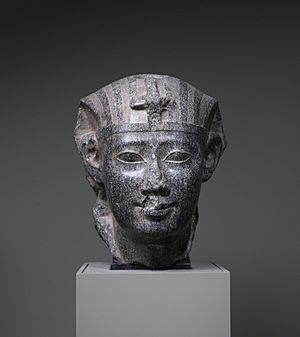
Ptolemy II tried to act like a traditional Egyptian pharaoh. He supported the Egyptian priests. Two stone tablets, the Mendes stele and the Pithom stele, record his actions. They show him performing ancient rituals and building temples. The Pithom stele mentions that he recovered religious statues from the Seleucids. This made the Seleucids look like enemies of Egypt, similar to the Hyksos or Persians.
Ptolemy II paid for many building projects at temples across Egypt. He ordered the main part of the Temple of Isis at Philae to be built. He also gave the temple money from taxes collected in the newly conquered Dodekaschoinos region. This made Philae one of the most important temples in Egypt.
He also started work at other sites, including:
- Decorations at the Temple of Anhur-Shu at Sebennytos.
- The Temple of Horus at Tanis.
- The Temple of Arsinoe at Pithom.
- Restoration of the Temple of Min at Akhmin.
- Expansion of the Dendera Temple complex.
- Work on the Temple of Opet at Karnak.
Government and Economy
Ptolemaic Egypt had a very complex government system. Much of it was likely developed under Ptolemy I, but we have more evidence from Ptolemy II's time. At the top, in Alexandria, a small group of trusted officials helped the king. The dioiketes (household manager) was a very important official. He was in charge of taxes and managing the provinces. Apollonius held this role for most of Ptolemy II's reign.
Egypt was divided into 39 districts called nomes. Each nome had three main officials: the nomarch (in charge of farming), the oikonomos (in charge of money), and the royal secretary (in charge of records). These officials reported to the dioiketes. The goal was to prevent any one official from becoming too powerful. Each village also had its own leaders.
This system created a clear chain of command from the king down to every village. Each nome also had a general who managed the soldiers there.
A main goal of this system was to collect as much wealth as possible from the land. This money was used for royal projects, especially wars. The system was very efficient under Ptolemy II.
To increase income, a decree called the Revenue Laws Papyrus was issued in 259 BC. It set up a system where private individuals paid the king a lump sum for the right to oversee tax collection. These "tax farmers" kept any extra money they collected.
In 258 BC, a 'General Inventory' surveyed all of Egypt. This helped determine how much income could be collected from different types of land. Efforts were made to create more farmland, especially by draining parts of Lake Moeris in the Fayyum. Ptolemy gave this new land to his soldiers as farms. Ptolemy II also started large gold mining operations in Nubia and the eastern desert.
Learning and Arts
Ptolemy II loved learning and supported scholars. He funded the expansion of the Library of Alexandria and supported scientific research. Poets like Callimachus and Theocritus received money from the king. They created great works of poetry, including poems praising the Ptolemaic family.
Other famous scholars who worked under Ptolemy included the mathematician Euclid and the astronomer Aristarchus. Ptolemy is also thought to have asked Manetho to write his Aegyptiaca, a history of Egypt. This book might have helped the new Greek rulers understand Egyptian culture.
There is a story that Ptolemy ordered the Hebrew Bible to be translated into Greek, known as the Septuagint. While the Greek translation likely happened in Alexandria, Ptolemy's exact role is not clear.
International Relations
Ptolemy II had very good relations with King Hiero II of Syracuse. They exchanged goods and ideas. Hiero even copied parts of Ptolemy's royal style and tax system. Famous scholars like the poet Theocritus and the mathematician Archimedes came from Syracuse and worked in Ptolemy's court.
Ptolemy II also had good relations with Carthage. This was different from his father, who had fought with them. One reason might have been to counter his brother Magas, who shared a border with Carthage.
Ptolemy was also the first Egyptian ruler to have official relations with the Roman Republic. An embassy from Ptolemy visited Rome in 273 BC and formed a friendship. These friendships were tested when the First Punic War broke out between Carthage and Rome in 264 BC. But Ptolemy II remained neutral and did not help either side with money.
Relations with India
The Roman writer Pliny the Elder recorded that Ptolemy sent an ambassador named Dionysius to the Mauryan Empire in India. This was likely to Emperor Ashoka. This shows that Ptolemy II's empire had connections reaching as far as India.
Marriages and Children
Ptolemy II married Arsinoe I, the daughter of Lysimachus, between 284 and 281 BC. They had three children:
| Name | Image | Birth | Death | Notes |
|---|---|---|---|---|
| Ptolemy III |  |
c. 285–275 BC | October/December 222 BC | Became king after his father in 246 BC. |
| Lysimachus | 221 BC | |||
| Berenice | c. 275 BC? | September/October 246 BC | Married the Seleucid king Antiochus II. |
Ptolemy II later separated from Arsinoe I. Around 273 BC, he married his sister Arsinoe II. They did not have children together. However, Ptolemy II's children with Arsinoe I were legally declared to be Arsinoe II's children.
Ptolemy II also had several other partners. With a woman named Bilistiche, he had an illegitimate son named Ptolemy Andromachou.
See also
 In Spanish: Ptolomeo II para niños
In Spanish: Ptolomeo II para niños
- Alexandrian Pleiad
- Library of Alexandria
- Ptolemaic period – period of Egyptian history during the Ptolemaic dynasty
- Ptolemais (disambiguation) – towns and cities named after members of the Ptolemaic dynasty
- Ancient Greece–Ancient India relations
Images for kids


